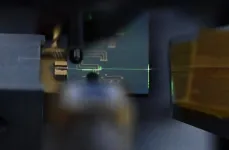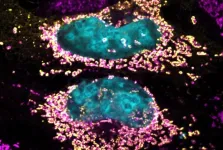(Press-News.org) New survey data from the 7th National Audit Project of the Royal College of Anaesthetists (NAP7) published in Anaesthesia (the journal of the Association of Anaesthetists) shows that potentially serious complications occur in one in 18 procedures under the care of an anaesthetist.
The risk factors associated with these potentially serious complications include very young age (babies); comorbidities; being male; increased frailty; the urgency and extent of surgery; and surgery taking place at night and/or at weekends.
This paper has been produced by a team of authors across UK hospitals including; Dr Andrew Kane, Consultant in Anaesthesia, James Cook University Hospital, Middlesbrough and Fellow, Health Services Research Centre, Royal College of Anaesthetists, London, UK; Dr Jasmeet Soar, Consultant in Anaesthesia and Intensive Care Medicine, Southmead Hospital, North Bristol NHS Trust, Bristol, UK; and Professor Tim Cook, Consultant in Anaesthesia and Intensive Care Medicine, Royal United Hospitals Bath NHS Foundation Trust, Bath, UK, and Honorary Professor, School of Medicine, University of Bristol, UK.
Complications and critical incidents during anaesthesia, arising due to patient, surgical or anaesthetic factors, may cause harm themselves or progress to more severe events, including cardiac arrest or death. As part of the Royal College of Anaesthetists' 7th National Audit Project, which focuses on peri-operative cardiac arrest, the authors studied a prospective national cohort of unselected patients.
Anaesthetists recorded anonymous details of all cases undertaken over four days at their site through an online survey. Of 416 hospital sites invited to participate, 352 (85%) completed the study. Obstetric cases were analysed separately and will be the focus of a separate paper later. Of 20,996 non-obstetric cases, 1,705 potentially serious complications were reported during 1,150 (5.5%) cases. Circulatory events (such as severely low blood pressure or abnormalities of heart rate and rhythm) accounted for most of these complications [616 (36%)], followed by airway complications (e.g. low oxygen levels) [418 (25%)], metabolic [264 (15%)], breathing (e.g. difficulty in ventilating the lungs) [259 (15%)], ‘other’ [107 (6%)] and neurological [41 (2%)] events. A single complication was reported in 851 (4%) of total cases, two complications in 166 (1%), and three or more complications in 133 (1%).
In elective surgery, all complications were ‘uncommon’ (1-10 per 1000 cases) or even less frequent. Emergency (urgent and immediate priority) surgery accounted for 3454 (16%) of the included cases but 714 (42%) of the recorded complications with severe low blood pressure (hypotension), major bleeding, severe alterations in heart rhythm (arrhythmias), septic shock, significant acidosis, and electrolyte (mineral) disturbances all being ‘common’ (10-100 per 1000 cases).
Complications were associated with very young age (less than 1 year); higher comorbidity as assessed by the American Society of Anesthesiology (ASA) physical status; male sex; increased frailty; urgency and extent of surgery; day of the week (higher risk at weekends); and time of day.
The estimated risk of complications by risk factors were as follows:
Lines with * are the most prominent effects - babies, high ASA (‘serious underlying medical issues’), emergency surgery (e.g. bleeding from trauma), operations at night (nearly all emergencies)
*New-born babies (age less than 28 days) (18%) 3.8 times higher risk than young adults (19-25y, 4.7%)
Older adults compared with younger adults (19-25y, 4.7%):
Adults aged 66-75 y – 6.0%, 28% higher risk
Adults aged 76-85 y – 6.1%, 30% higher risk
Adults aged over 85 y - 5.7%, 21% higher risk
*ASA1 (fit and healthy, 3.5%) v ASA 4 (patient with major medical conditions e.g. heart or lung disease, 19%), 5.5 times increased risk for ASA 4 patients
Males (6.4%) v females (4.7%), 40% higher risk for males
Frail (e.g. needing help with daily activities such as cooking, shopping and housework 8.5%) vs. non-frail (4.5%), double the risk for patients who are frail
*Emergency (‘urgent surgery’ 8.8%, ‘immediate surgery’ 39%) vs. elective (4%): immediate surgery 10 times risk versus elective, and 4 times the risk of urgent (see notes to editor)
Minor surgery (e.g. skin lump removal, 3.4%) vs. complex major surgery (e.g. bowel resection for cancer, 9%) 2.5 times increased risk for complex major surgery
Weekday (approx. 5%) vs. weekend (Sat 6.5%, Sun 10%) thus increased risk of 30% for Saturday vs. weekday and double risk for Sunday vs weekday
*Night-time surgery (20%) versus daytime (5%) – 4 times increased risk for night-time vs. daytime
Importantly, the above comparisons are univariate (comparing only one factor) and factors interact. For instance, at weekends and nighttime only the most urgent cases are operated on, often being in elderly, frail and unwell patients. It maybe these factors in combination are the cause of increased complications at this time. Similarly almost all neonatal surgery is urgent and major in babies who are unwell which in part accounts for the higher rate for complications.
Dr Kane says: “These new data from the NAP7 Activity Survey present the first estimates for the rates of potentially serious complications and critical incidents observed during modern anaesthetic practice. The data confirm that during elective practice, individual complications are uncommon, and this is reassuring for patients, surgeons and anaesthetists. Conversely, the data also highlight the relatively higher rate of complications in emergency settings.”
Prof Cook adds “The data show the potentially serious consequences occur frequently during anaesthesia and these may arise from patient, surgery or anaesthetic causes. Almost all anaesthesia care in the UK is provided by highly trained doctors and the data show that although anaesthesia is not a risk-free undertaking, the care delivered by the anaesthesia and surgical team means very few of these events progress to patient harm and anaesthesia remains very safe.”
Dr Soar concludes: “As part of the same project we recently reported that patients have become older, have more comorbidities and more often living with obesity than a decade ago. All these factors, combined with the complications we report today, make undergoing anaesthesia and surgery intrinsically more hazardous. Our findings are likely to be of value for risk assessment and consent.”
Dr Fiona Donald, President of the Royal College of Anaesthetists, said: “Anaesthesia remains very safe and anaesthetists along with the whole surgical team are doing a good job of managing complications when they arise. But the more we understand about which patients are at greater risk of complications and the reasons for that, the better equipped we are to make further improvements in perioperative care and this study takes us a long way along that road of understanding.”
Note that this paper includes the results from NAP7, which will be published in full on 17 November 2023. The Royal College of Anaesthetists National Audit Projects study rare but potentially serious complications related to anaesthesia. They are intended to examine, report on and drive improvements in practice and are delivered by the Royal College of Anaesthetists’ Centre for Research and Improvement. Each NAP focuses on a different topic important to patients and anaesthetists. NAP7 examines perioperative cardiac arrest.
Notes to editor:
Surgery definitions:
https://www.ncepod.org.uk/classification.html
IMMEDIATE – Immediate life, limb or organ-saving intervention – resuscitation simultaneous with intervention. Normally within minutes of decision to operate.Life-saving, Other e.g. limb or organ saving
URGENT – Intervention for acute onset or clinical deterioration of potentially life-threatening conditions, for those conditions that may threaten the survival of limb or organ, for fixation of many fractures and for relief of pain or other distressing symptoms. Normally within hours of decision to operate.
ELECTIVE – Intervention planned or booked in advance of routine admission to hospital. Timing to suit patient, hospital and staff.
END
National analysis suggests that potentially serious complications occur in 1 in 18 procedures under the care of an anaesthetist
Risk factors associated with complications in anaesthesia include very young age; comorbidities; being male; increased frailty; the urgency and extent of surgery; and surgery taking place at night and/or at weekends
2023-11-10
ELSE PRESS RELEASES FROM THIS DATE:
Study finds that laser epilation reduces risk of recurrence of pilonidal disease
2023-11-09
Laser epilation, commonly known as laser hair removal, reduced the risk of recurrence in patients with pilonidal disease, an inflammatory, painful, and sometimes chronic or recurring condition, according to research conducted by Peter C. Minneci, M.D., Chair of Surgery at Nemours Children’s Health, Delaware Valley, and published in JAMA Surgery.
Pilonidal disease occurs when cysts form between the buttocks. It is believed to be an inflammatory reaction to hair or debris that gets caught in the crease of the buttocks. The disease occurs in 26 to 100 per 100,000 people and is most common in adolescents and young ...
The U.S. Supreme Court restricted abortion rights and public support for abortion increased
2023-11-09
A new study examining the effects of the U.S. Supreme Court ruling on Dobbs v. Jackson Women's Health Organization on June 24, 2022, which overturned Roe v. Wade's constitutional protection of abortion rights, finds that the American public's support for abortion increased after the decision.
The findings were published today in Nature Behaviour.
"Our results show the extent to which the Supreme Court is out of step with the American public," says co-author Sean Westwood, an associate professor of government at Dartmouth and director of the Polarization Research Lab.
The study's findings were based on a large, three-wave survey before the leak ...
New evidence that heightened pain sensitivity is linked to sympathy for opposing political views
2023-11-09
The next time your friend displays remarkable openness to their opposite political camp’s ideas, you might try pinching them.
Okay, we don’t really recommend that. But new evidence shows that people with increased sensitivity to pain are also more likely to endorse values more common to people of their opposite political persuasion. It doesn’t stop there. They also show stronger support for the other camp’s politicians, and, get this -- more likely to vote for Donald Trump in 2020 if they are liberal, or Joe Biden if they are conservative.
Even ...
C-Path’s pioneering neuroscience workshop transforms the landscape of neurological disorder therapies
2023-11-09
Critical Path Institute (C-Path) is pleased to announce the release of a new peer-reviewed publication, titled “Transforming Drug Development for Neurological Disorders: Proceedings from a Multi-disease Area Workshop,” now published in Neurotherapeutics, The Journal of the American Society for Experimental Neurotherapeutics.
A distinguished team of C-Path scientists and patient-advocates spearheaded by Diane Stephenson, Ph.D., C-Path’s Executive Director of the Critical Path for Parkinson’s Consortium (CPP), has presented its learnings from C-Path’s 2022 Neuroscience Program Annual Workshop. The publication can be accessed in its entirety here.
Neurological ...
How to use AI for discovery — without leading science astray
2023-11-09
Over the past decade, AI has permeated nearly every corner of science: Machine learning models have been used to predict protein structures, estimate the fraction of the Amazon rainforest that has been lost to deforestation and even classify faraway galaxies that might be home to exoplanets.
But while AI can be used to speed scientific discovery — helping researchers make predictions about phenomena that may be difficult or costly to study in the real world — it can also lead scientists astray. In the same way that chatbots sometimes “hallucinate,” ...
Ultrafast lasers on ultra-tiny chips
2023-11-09
Lasers have become relatively commonplace in everyday life, but they have many uses outside of providing light shows at raves and scanning barcodes on groceries. Lasers are also of great importance in telecommunications and computing as well as biology, chemistry, and physics research.
In those latter applications, lasers that can emit extremely short pulses—those on the order of one-trillionth of a second (one picosecond) or shorter—are especially useful. Using lasers operating on such small timescales, researchers can study physical and chemical ...
Pesticides, herbicides, fungicides detected in New York state beeswax
2023-11-09
An analysis of beeswax in managed honeybee hives in New York found a wide variety of pesticide, herbicide and fungicide residues – exposing current and future generations of bees to long-term toxicity.
The study, published in the Journal of Veterinary Diagnostic Investigation, notes that people may be similarly exposed through contaminated honey, pollen and wax in cosmetics. Though the chemicals found in wax are not beneficial to humans, the small amounts in these products are unlikely to ...
Study reveals bacterial protein capable of keeping human cells healthy
2023-11-09
Researchers at the University of São Paulo (USP) in Brazil, partnering with colleagues in Australia, have identified a novel bacterial protein that can keep human cells healthy even when the cells have a heavy bacterial burden. The discovery could lead to new treatments for a wide array of diseases relating to mitochondrial dysfunction, such as cancer and auto-immune disorders. Mitochondria are organelles that supply most of the chemical energy needed to power cells’ biochemical reactions.
An article on the study is published in the journal PNAS. The researchers ...
Endangered thick-billed parrots at risk of losing newly identified, unprotected Sierra Madre forest habitats to logging, deforestation, study shows
2023-11-09
DOWNLOAD PHOTOS AND VIDEO: https://sandiegozoo.box.com/s/x50kzaoukdtyjxsv9mzqgn0fu1m6kddk
A binational team of scientists, using creativity and innovation, adorned dozens of endangered thick-billed parrots with tiny solar-powered satellite transmitters to track and reveal their winter migratory nesting sites in the remote treetops of the Sierra Madre Occidental ranges. Their research reveals new critical habitat, 80% of which has no formal protection.
In a study published this month in the journal Global ...
Atomic dance gives rise to a magnet
2023-11-09
Quantum materials hold the key to a future of lightning-speed, energy-efficient information systems. The problem with tapping their transformative potential is that, in solids, the vast number of atoms often drowns out the exotic quantum properties electrons carry.
Rice University researchers in the lab of quantum materials scientist Hanyu Zhu found that when they move in circles, atoms can also work wonders: When the atomic lattice in a rare-earth crystal becomes animated with a corkscrew-shaped vibration known as a chiral phonon, the crystal is transformed ...
LAST 30 PRESS RELEASES:
New expert guidance urges caution before surgery for patients with treatment-resistant constipation
Solar hydrogen can now be produced efficiently without the scarce metal platinum
Sleeping in on weekends may help boost teens’ mental health
Study: Teens use cellphones for an hour a day at school
After more than two years of war, Palestinian children are hungry, denied education and “like the living dead”
The untold story of life with Prader-Willi syndrome - according to the siblings who live it
How the parasite that ‘gave up sex’ found more hosts – and why its victory won’t last
When is it time to jump? The boiling frog problem of AI use in physics education
Twitter data reveals partisan divide in understanding why pollen season's getting worse
AI is quick but risky for updating old software
Revolutionizing biosecurity: new multi-omics framework to transform invasive species management
From ancient herb to modern medicine: new review unveils the multi-targeted healing potential of Borago officinalis
Building a global scientific community: Biological Diversity Journal announces dual recruitment of Editorial Board and Youth Editorial Board members
Microbes that break down antibiotics help protect ecosystems under drug pollution
Smart biochar that remembers pollutants offers a new way to clean water and recycle biomass
Rice genes matter more than domestication in shaping plant microbiomes
Ticking time bomb: Some farmers report as many as 70 tick encounters over a 6-month period
Turning garden and crop waste into plastics
Scientists discover ‘platypus galaxies’ in the early universe
Seeing thyroid cancer in a new light: when AI meets label-free imaging in the operating room
Neutrophil-to-lymphocyte ratio may aid risk stratification in depressive disorder
2026 Seismological Society of America Annual Meeting
AI-powered ECG analysis offers promising path for early detection of chronic obstructive pulmonary disease, says Mount Sinai researchers
GIMM uncovers flaws in lab-grown heart cells and paves the way for improved treatments
Cracking the evolutionary code of sleep
Medications could help the aging brain cope with surgery, memory impairment
Back pain linked to worse sleep years later in men over 65, according to study
CDC urges ‘shared decision-making’ on some childhood vaccines; many unclear about what that means
New research finds that an ‘equal treatment’ approach to economic opportunity advertising can backfire
Researchers create shape-shifting, self-navigating microparticles
[Press-News.org] National analysis suggests that potentially serious complications occur in 1 in 18 procedures under the care of an anaesthetistRisk factors associated with complications in anaesthesia include very young age; comorbidities; being male; increased frailty; the urgency and extent of surgery; and surgery taking place at night and/or at weekends




